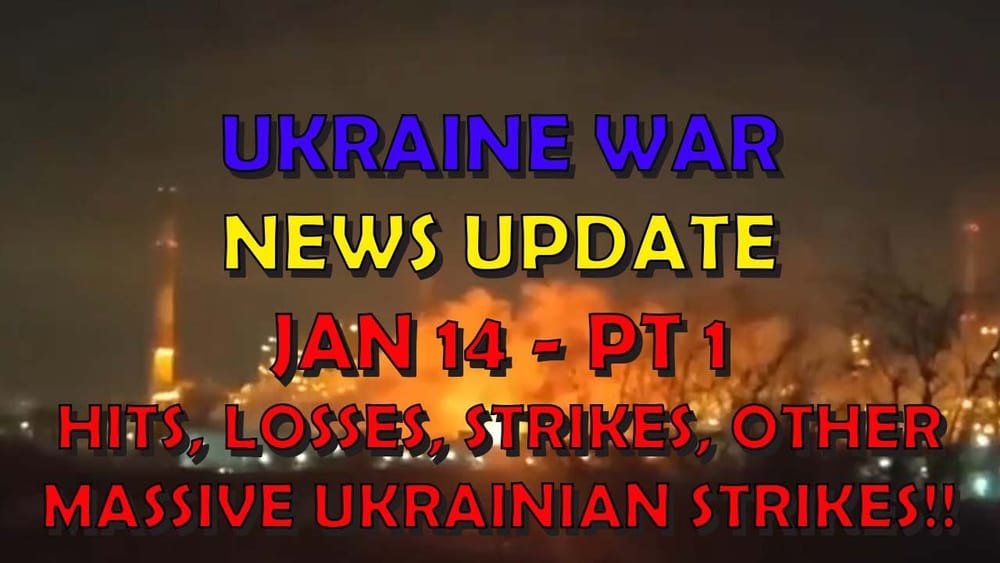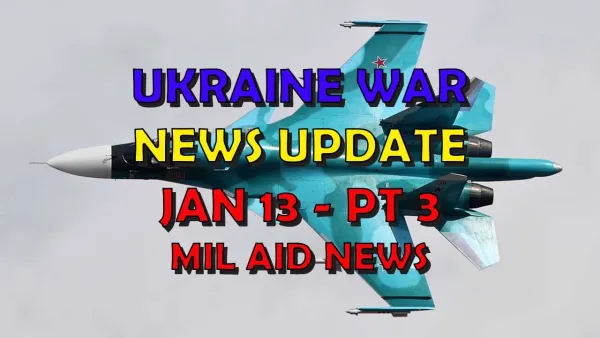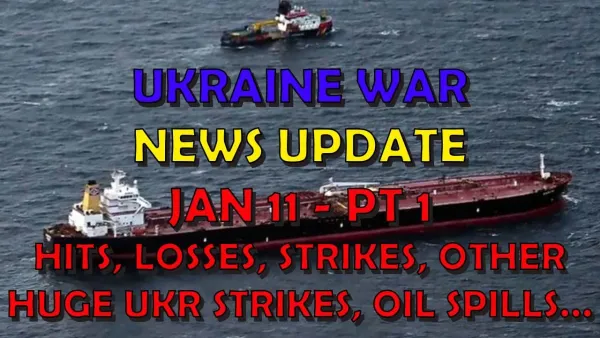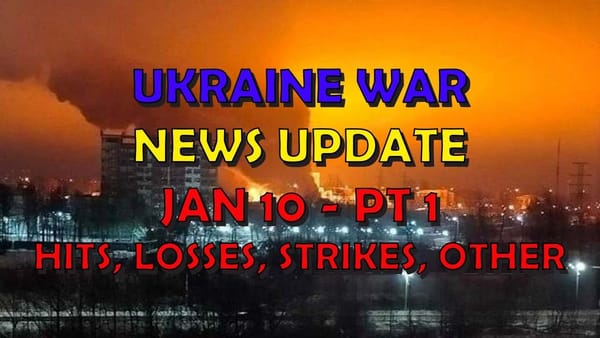Ukraine War Update NEWS: Pt 1 - Overnight & Other News - Massive Ukrainian Strikes!!
Table of Contents 📖
"Victory is when all those useless people drop dead. Then we'll have victory... Those who are far away. Not in Russia. So, in other words, when all the Ukrainians drop dead, then we'll win the war."
🤖💭 AI Plan (pre task) - the AI's step by step thought process
Hello Team and Russian losses according to Ukrainian General Staff figures for 13th January 2025
🎦 00:00-00:24⏩
- Jonathan welcomes viewers to the Ukraine War News Update for 14th January 2025, part 1.
- He notes it has been a "crazy night" in terms of strikes on Russia.
- He begins by reviewing the Ukrainian General Staff figures for Russian losses from the previous day (13th January 2025), with the usual caveats that these figures are Ukrainian claims and should be treated with caution.
🪦 DISCLAIMER FOR GENERAL STAFF LOSSES DATA
- These are real people with real lives and real families who love them. Don’t let the numbers sap your humanity.
- These numbers probably aren’t accurate but they’re the best we have and we don’t need them to be accurate to be indicative of patterns of activity.
- All losses are estimates. Losses cannot be counted with accuracy because of the conditions on the ground.
- Both sides would see it to be of their advantage to minimize their own losses maximize the other side’s losses.
- Neither side releases their losses but we have enough transparency from the Ukrainian side to have confidence in they are indicative.
- Personnel losses are hard to count. If a soldier gets injured, heals up, and returns to the front line only to get injured again, is that one loss or two? Also, how to deal with losses from PMC’s or soldiers fighting with RF from occupied territories?
- Equipment losses are hard to count. If an AA complex involves several parts and one part gets disabled, is that a loss, or a fraction of a loss? If a tank gets disabled, repaired, back into the fight, then disabled again, is that one lost tank or two?
- All recorded losses are vulnerable to multiple reporting. We have already seen numerous cases of multiple drones in the air reporting the same loss from different angles as multiple engagements.
- Losses are not always reported on the same day they occurred. It is frequent that drone losses are reported at least 24 hours after other terrestrial equipment losses. Certain losses may not be reported for days or weeks for military intelligence reasons.
Analysis of Russian losses: Lower troop losses but increase in artillery systems
🎦 00:24-01:14⏩
- Russian losses reported by Ukraine include:
- 1,330 personnel - lower than recent peaks but still high.
- 3 tanks - a decrease.
- 11 troop-carrying AFVs - a decrease.
- 47 artillery systems - a significant increase, more than double the daily average.
- 1 MLRS.
- 83 vehicles and fuel tanks - a significant number.
- 1 piece of special equipment.
- Jonathan concludes that the numbers are still challenging for Russia, despite some categories showing a decrease compared to previous weeks.
Video evidence of North Korean bodies in Kursk region
🎦 01:14-01:46⏩
- A video, which Jonathan does not play due to potential content restrictions, purportedly shows over 20 bodies stacked in a line, identified as North Korean soldiers.
- The location is stated as the Kursk region, a concentration point for eliminated Russian and North Korean soldiers, according to Ukrainian aerial reconnaissance.
- War Translated suggests this is further evidence of significant North Korean troop losses, which Russia is trying to conceal, potentially by disfiguring the faces of the deceased.
Capture of Italian mercenary and paedophile fighting for Russia near Kupyansk
🎦 01:46-02:57⏩
- Ukrainian paratroopers from the 78th Separate Air Assault Regiment captured an Italian mercenary near Kupyansk.
- The mercenary, Gianni Cernini, was identified as a convicted paedophile who had escaped from Italy to Russia.
- He had been sentenced to seven years in prison in Italy for sexual violence against a nine-year-old girl and had a previous conviction for killing a colleague in 1999.
- Cernini had been working in restaurants in Samara, Russia, before being likely recruited from prison to fight for Russia in Ukraine.
Ukraine uses French AASM-250 Hammer guided glide bombs to strike Russian military location in Kursk
🎦 02:57-03:57⏩
- Ukraine is using French AASM-250 Hammer guided glide bombs effectively. Jonathan is unsure of the current supply levels from France, but initially, Ukraine was receiving 50 per month.
- Video footage (not played) shows a strike on a Russian military location in Kursk. A large building is shown being destroyed by the guided bomb.
- Jonathan notes the "devastating effect" of these bombs, which "pack a punch".
Speculation on reduced Russian missile and guided bomb usage and Engels airbase attacks
🎦 03:57-04:24⏩
- Jonathan speculates that Russia may be using fewer of their own guided bombs and missiles recently, although he lacks concrete statistics.
- He mentions reports of further strikes on Engels airbase or nearby kerosene storage facilities, suggesting these attacks may be impacting Russia's bomber operations.
FSB officer murdered in Ministry of Defence building in Moscow
🎦 04:24-04:58⏩
- An FSB officer, Vladimir Feschenko, was found murdered in his office within Russia's Ministry of Defence building in central Moscow, according to RIA Novosti.
- Jonathan considers various possible explanations, including the possibility of the officer being a double agent or internal disputes, but concludes the reason is unknown.
Arson attacks in Russia as a form of sabotage and "weapon of choice" in 2025
🎦 04:58-06:54⏩
- Jonathan references an article by Shashank Joshi of The Economist highlighting increasing arson attacks in Russia.
- He has previously suggested fire would become a significant weapon in this conflict.
- Fire is described as a low-cost, low-risk form of devastation, easy to execute (using flammable materials) and potentially difficult to trace back to perpetrators.
- He mentions the "sabotage gig economy" where individuals are paid (possibly via the dark web for small sums) to commit arson attacks in Russia, allegedly orchestrated by Ukraine.
- Jonathan expresses his personal dislike of fire as a "horrific" and "wanton" form of destruction.
Ukrainian air defence success against Iranian Shahed drones
🎦 06:54-07:24⏩
- Ukrainian air defences reportedly shot down almost all of the 80 Shahed drones launched by Russia overnight.
- 58 Shaheds were shot down and 21 suppressed by electronic warfare, leaving only one likely to have hit its target.
- Jonathan highlights this as a significant success for Ukrainian air defence.
Massive Ukrainian strikes deep inside Russia, targeting military production
🎦 07:24-08:32⏩
- Jonathan states that Ukraine is escalating attacks on Russia, particularly targeting Russia's economy and military-industrial complex, as predicted.
- He believes Ukraine has scaled up production of long-range munitions and is now consistently using them in "huge waves of attacks" into Russia every night.
- Last night's attacks were particularly widespread.
- Ukrainian Presidential officials are hinting at hitting military production facilities inside Russia.
Bryansk region chemical plant attack details
🎦 08:32-09:15⏩
- Bryansk region, bordering Ukraine, appears to have been heavily targeted.
- A chemical plant in Bryansk, the Techmash plant producing explosives, part of the Techmash holding which receives orders from the Ministry of Defence in Moscow, was reportedly hit.
- Russia claims all incoming attacks were shot down in Bryansk, but local sources confirm the chemical plant was hit.
- Local government claims a house caught fire from falling debris.
Reports of drone attacks across 12 Russian regions and airport restrictions
🎦 09:15-09:47⏩
- Russian Telegram channels are reporting drone attacks across 12 regions of Russia overnight, with estimates of 100-200 drones involved.
- Airports in Kazan, Kaluga, Saratov, Tambov, Penza, Nizhnyakansk, and Ulyanovsk faced restrictions.
- Emergency blackouts were introduced in settlements in Russia's Belgorod region, also targeted.
Geographic spread of Ukrainian strikes: Tatarstan, Saratov, Tula, Orel, Bryansk, Belgorod, Voronezh, Rostov
🎦 09:47-10:38⏩
- Jonathan shows a map highlighting regions targeted in the drone attacks, illustrating the deep reach into Russia:
- Tatarstan: Location of the Al-Abuga facility producing Shahed drones.
- Saratov: Location of Engels Air Base and oil/kerosene storage depots, potentially hit again.
- Tula, Orel, Bryansk: Took the brunt of the attacks.
- Belgorod: Border region, also targeted.
- Voronezh, Rostov: Rostov is routinely targeted.
- Russian claims of drones shot down are listed for Rostov (14), Orel (17), Tula (17), and other regions without specific numbers, suggesting a large scale attack.
Targets list including oil refineries, chemical plants, and military facilities
🎦 10:38-11:28⏩
- MAX24 lists targets reportedly hit by drones, ATACMS, and Storm Shadow missiles:
- Saratov Oil Refinery.
- Engels Oil Depot.
- Bryansk Chemical Plant.
- Kremlin L Plant.
- Gas Tank in Kazan.
- Ogzintz Plant in Kazan.
- Tambov, Voronezh, Tula, Orel, and Rostov Regions.
- Videos confirm "huge explosions and fires" in various locations, indicating a "torrid night" for Russia, particularly in the Bryansk region.
Video evidence of a missile strike in Bryansk region despite Russian denials
🎦 11:28-13:25⏩
- Jonathan describes a video (linked in description) showing a fast-moving missile hitting a target in the Bryansk region.
- Despite Russian claims that nothing got through, the video clearly shows a missile impact and a massive explosion, contradicting Russian denials.
- A longer video from a member of the public also filmed the attack on the chemical plant in Seltso, Bryansk region, about 120km from the Ukrainian border.
- This further confirms that multiple missiles bypassed Russian air defences and hit a "major military target".
Expansion of Bryansk chemical plant in recent years and its military significance
🎦 13:25-14:26⏩
- Exelenova Telegram channel shows satellite images illustrating the rapid expansion of the Bryansk chemical plant since October 2022.
- Daniela from Turchini provides analysis (linked in description) showing plant refurbishment and expansion, suggesting its growing importance.
- The plant is identified as producing explosives and propellants for various Russian military systems, including missiles for GRADS, Tornado, Uragan, TOS-1 Buratino, RPGs, artillery charges, and explosives for gravity bombs including FAB guided glide bombs.
- The attack is assessed as specifically intended to weaken Russia's capacity to wage war, especially if it is involved in producing FAB bombs.
Damage assessment of Bryansk chemical plant strike and reports of multiple explosions
🎦 14:26-15:53⏩
- Thierry Smidlin points out the proximity of military depots to the Bryansk chemical plant, suggesting wider strategic importance of the area.
- Bryansk residents reported powerful explosions and a large fire.
- Speculation suggests the strike on the Bryansk chemical plant was carried out by ATACMS missiles.
- Daniela from Turchini notes the absence of drone sounds and air defence activity in videos of the strike, supporting the theory of a ballistic missile attack.
- Sequential hits followed by larger explosions further suggest a ballistic attack.
Satellite imagery analysis of Bryansk chemical plant expansion and production
🎦 15:53-17:27⏩
- Daniela's analysis using satellite images reveals expansion activities at the plant, including clearing trees and refurbishment of buildings.
- The plant's crucial role in producing explosives and propellants for multiple Russian weapon systems is highlighted, based on an interview with the plant's technical director.
- The plant's production includes components for missiles, rockets, grenades, artillery, and guided bombs (FAB).
- The attack is concluded to be aimed at weakening Russia's war-making capacity by targeting this key production facility.
Weather impact on damage assessment and further reports of Bryansk missile attacks
- Weather conditions are preventing detailed damage assessment of the Bryansk plant. High-resolution satellite imagery is infrequent and weather-dependent.
- Further video footage documents heavy missile attacks against Russian targets in Bryansk, with multiple Telegram channels reporting explosions from different locations.
- One report counted 14 explosions, potentially hitting the explosives factory or separate missile impacts.
Bryansk Kremni L microelectronics plant, a key military supplier, reportedly hit again
🎦 18:32-19:13⏩
- Locals in Bryansk report smoke coming from the Bryansk Kremni L enterprise.
- This plant is identified as one of the largest suppliers of military microelectronics in Russia and has reportedly been hit before.
- Jonathan states he is "absolutely positive" this plant has been targeted previously, emphasizing its importance to the Russian military-industrial complex.
Chemical plant in Tula and other damage in the region
🎦 19:13-19:31⏩
- A chemical plant in Tula is reported to be hit, crucial for the manufacture of explosives for Russia's war effort.
- The Alexin thermal power plant and the metalworks, Tula Chermets, also suffered damage, possibly from debris, with one serviceman injured.
Fire at Gazprom liquefied gas facility near Kazan, not tank plant as initially reported
🎦 19:31-20:09⏩
- An explosion near Kazan was initially thought to be at a tank plant.
- However, the largest fire has been geolocated to a Gazprom liquefied gas facility in the Moscow district of Kazan.
- This indicates a significant expansion of targets beyond military production to energy infrastructure.
Ukrainian drone attack attempt on Almetayevsk oil pumping station in Tatarstan
🎦 20:09-20:50⏩
- Ukrainian drones reportedly attempted to attack Almetayevsk in Tatarstan, a long-range strike.
- Russian sources claim two fixed-wing drones were intercepted and destroyed over the city.
- The drones were reportedly targeting the Kalekino oil pumping station, a major transportation hub for Transneft, crucial for transporting Siberian oil to central Russia.
- This attack on energy infrastructure comes after Gazprom announced a potential 60% workforce reduction, highlighting Russia's economic challenges.
New drone attack and fire at Engels oil depot
🎦 20:50-21:31⏩
- Russian Telegram channels report a new drone attack and a "huge fire" at the Engels oil depot, suggesting repeated successful strikes on this location.
- The fire is described as "absolutely massive", possibly being a continuation of a fire that has been burning for five days.
Types of drones used in attacks, including Shahid analogues
🎦 21:31-22:05⏩
- Max24 reports the drone attack involved various types, including Shahid analogues, drones capable of carrying large mines, and "cubs".
- Nikolayevsky-Vanik also reports this mix of drone types.
- There are visual reports of black Shahid-like drones being used by Ukraine.
- Sanctions were reportedly re-imposed on Engels, and the 14th Long Range Aviation Regiment claimed successful targeting of Engels military airfield infrastructure.
- This suggests the targets are expanding beyond oil depots to include the airbase itself.
Saratov Oil Refinery fire and overall assessment of Ukrainian strikes
🎦 22:05-22:57⏩
- Fire reported at Saratov Oil Refinery, further indicating strikes in the Engels area.
- Jonathan concludes that last night was a "very significant night" and "insanely successful" for Ukraine's attacks, meeting expectations of increased long-range strikes.
Strategic rationale for Ukrainian long-range strikes and attrition warfare
🎦 22:57-24:47⏩
- Jonathan reiterates his long-held view that Ukraine can win the war by attriting Russia from a distance, minimizing Ukrainian troop losses.
- He emphasizes the strategic benefits of these attacks: damaging Russia's economy, military-industrial base, and overall capabilities without direct troop engagements.
- He stresses the need for Ukraine to consistently produce and deploy these long-range weapons to cripple Russia.
- He acknowledges the time and effort required to develop and produce these weapons, but notes Ukraine's rapid progress.
Potential impact of sustained Ukrainian strikes on Russia and future negotiations
🎦 24:47-25:22⏩
- Jonathan wonders if continued nightly attacks for the next six days leading up to a potential US presidential inauguration (20th January) could put Russia in a "heck of a difficult situation".
- He speculates this pressure could force Russia to the negotiating table, potentially influenced by a new US administration (Trump).
Russian public opinion: Apathy and distorted views on "victory"
🎦 25:22-27:08⏩
- Jonathan shares a clip from Thierry highlighting Russian public sentiment, showing a stark contrast to the strategic war analysis.
- A Russian woman interviewed expresses a desire for the war to end but defines "victory" as "when all those useless people drop dead," equating "useless people" with Ukrainians.
- Another older Russian man expresses trust in Putin but focuses on economic concerns and hopes for pension increases, highlighting the disconnect between war and daily life for some Russians.
- He mentions struggling to afford food for New Year's Eve, showing the economic impact on ordinary Russians.
- Jonathan notes that younger Russians may be less forthcoming with their opinions.
Sabotage of underwater energy cables in Baltic Sea attributed to Russia and China
🎦 27:08-28:39⏩
- Further evidence of anchor dragging damage is found on another underwater energy cable, the Nord Belt connecting Sweden and Lithuania.
- Swedish Defence Minister Karl Oskar Volyn attributes this damage to Russia and China, suggesting a wider pattern of sabotage.
- The damage is linked to the Chinese Yipeng-3 ship with a Russian captain, which allegedly dragged its anchor for 160km on November 17-18th, severing cables between Sweden, Lithuania, Germany, and Finland.
- Investigators believe this was intentional sabotage by the Russian intelligence services.
- These incidents may be related to the Baltic states' disconnection from the Belarusian-Russian power grid (BREL) in February.
- Lithuanian Deputy Minister of Energy, Arnoldas Pikdzerinis, emphasizes the need for a quick NATO reaction to protect critical infrastructure against sabotage.
Russian economic woes: Aviation industry collapse and farmers facing loan refusals
🎦 28:39-30:13⏩
- Dubai-based low-cost carrier and China Southern Airlines have halted flights to Moscow following EU agency warnings, further isolating Russia's aviation sector.
- Russian airline Tall Power Air (based in Kazan) has filed for bankruptcy, adding to the industry's struggles.
- Banks in Russia are withdrawing from preferential lending programs for farmers and refusing to issue preferential loans, citing high financial risks due to the high-interest rate.
- This is impacting the agricultural sector, with farmers in some regions reportedly selling their farms due to lack of financial support.
- This could have global implications for food supplies and prices.
Gazprom job cuts and Russia's looming demographic crisis and need for migration
🎦 30:13-37:29⏩
- Gazprom's announcement of massive job cuts (potentially 60% of workforce) is a significant indicator of Russia's economic problems.
- This is linked to Russia's demographic crisis, characterized by low birth rates and an aging population, common in developed economies.
- Jonathan explains the demographic challenge: declining birth rates mean fewer young people to support an increasing elderly population, straining the economy and tax base.
- He references Peter Zeihan's focus on this issue and notes it affects China and Ukraine as well. Ukraine has particularly low birth rates and high mortality.
- Capitalism's need for continual growth exacerbates this problem. Stagnant populations require migration to maintain economic function.
- Russia is experiencing population decline, with migration compensating for almost two-thirds of the loss.
- He discusses the "great replacement theory" in the context of economic necessity for migration, rather than conspiracy.
- He suggests Angela Merkel's migrant policy might have been driven by demographic and economic needs.
- Russia is expected to see a doubling of migrant influx by 2025-2027.
- Russia's ban on "advancing childlessness" is a desperate attempt to address low birth rates.
- Jonathan argues for the need to find alternative economic models to capitalism that can function without constant growth, given resource and population constraints.
- He questions how migration and demographic shifts will affect Russia's ability to wage war and its internal socio-political dynamics, especially regarding nationalism.
Wrap up
🎦 37:29-37:34⏩
- Jonathan concludes by referencing PS01 as the source for the demographic information.
- He signs off, saying "Take care, guys, and speak to you soon. Toodlepips."



